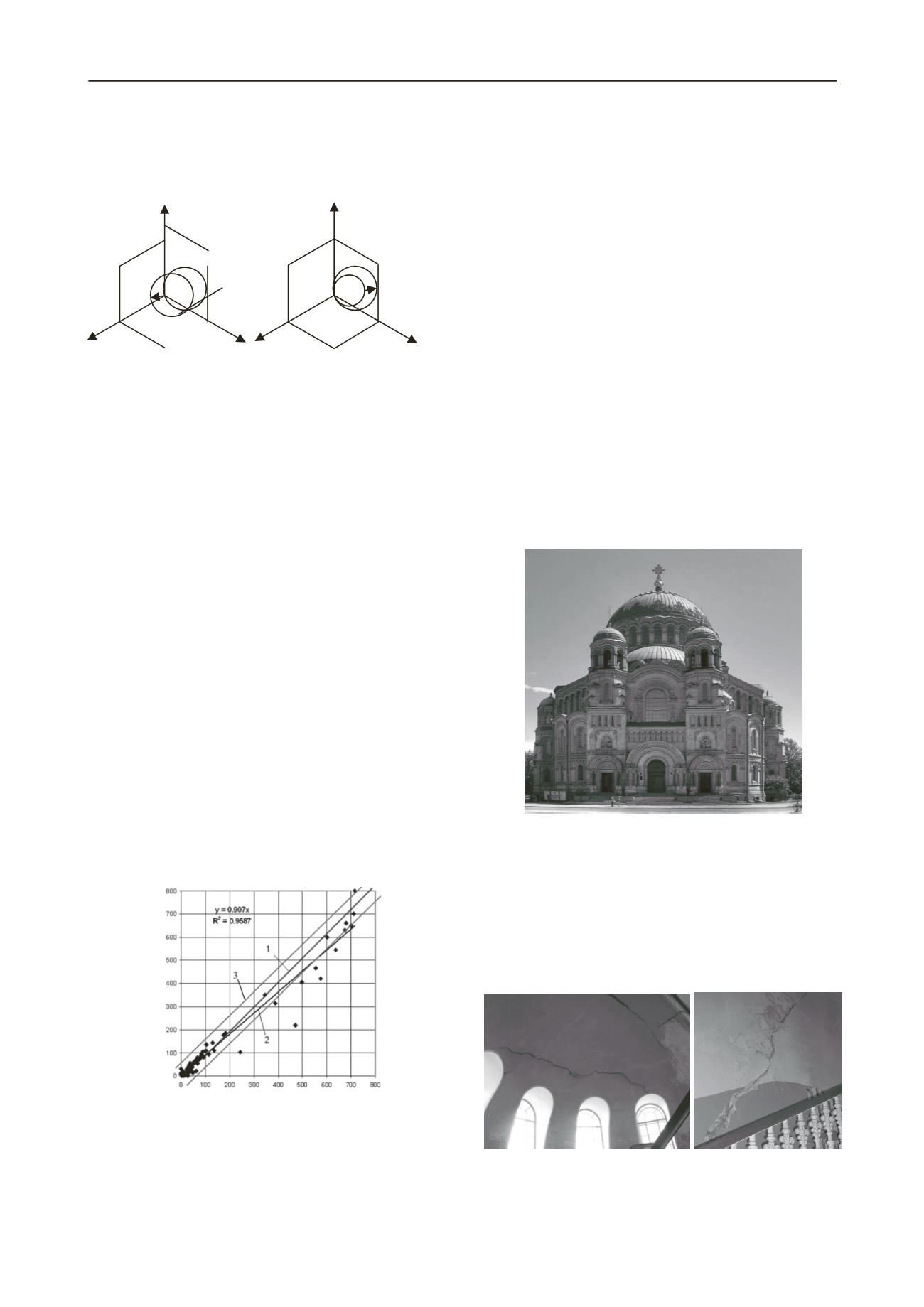
827
Technical Committee 103 /
Comité technique 103
directions have been significantly simplified and purged of
contradictions. Somewhat more detailed equations for the model
are contained in the paper of Shashkin (2010a). A fundamental
addition is introduction of anisotropic hardening (Fig. 3).
a
b
Fig. 3. A diagram of development of hardening area according to the
assumed model featuring anisotropic hardening: (
a
) hardening during
first loading, (
b
) change of location of hardening during reverse loading
During deviatoric loading the hardening zone in the model
develops anisotropically and is directed towards loading. When
the loading direction is changed the hardening zone moves, and
its size does not increase until the hydrostatic axis remains
within that zone. At translational movement of the hardening
zone, with loading ongoing in the opposite direction, the strain
is doubled, according to the Masing rule. As a result, the model
provides a correct representation of soil behaviour at
multidirectional loading. In that, taking into account anisotropy
of strain hardening, according to the assumed approach, does
not require introduction of any additional model parameters in
contrast to the isotropic hardening model.
A correct representation of soil behaviour under loading
following unloading and under multidirectional loading is
relevant not only for cyclic loading tasks (as it may initially
appear). Multidirectional loading of subsoil is encountered in
modelling of any building with a complex underground part,
which is very common in contemporary design. Indeed, when
bulk excavation is performed subsoil experiences a reduction of
volumetric stresses and a corresponding increase of deviatoric
stresses. As the superstructure is being added, volumetric
stresses increase, whereas deviatoric stresses at first decrease
and then increase in the opposite direction. Any model that does
not take into account hardening anisotropy, as shown by Fig. 8,
will radically underestimate strains present at the stage of
building the superstructure. Therefore, a proper account of
anisotropy hardening appears rather important as regards SSI.
Measured Settlement (mm)
Calculated Settlement (mm)
Fig. 4. Comparison of numerical analyses of settlements performed
through the offered non-linear independent hardening model and
monitoring results: 1 – perfect fit between computed and observed
settlements, 2 – linear approximation, 3 – standard deviation
The model was tested based on the settlement database
created under the auspices of ISSMGE TC 207, under the
programme of data collection for well-documented case
histories. Numerical analyses and monitoring results are
collated in Fig 4. As one can see from the figure, this model
provides a good accuracy of settlement calculation, and,
accordingly, can be used in day-to-day SSI analyses.
5 EXAMPLE OF SSI ANALYSES USED IN
CONTEMPORARY DESIGN PRACTICE
Below we shall give an example of how effectively SSI
analyses can be used in real day-to-day design applications.
St. Nicholas Naval Cathedral is located in the town of
Kronshtadt (Fig. 5). It was built in 1902-1913 according to the
project of V.A. Kossiakoff. In this cathedral an idea of a
classical cruciform church with a domed roof was fulfilled. This
idea was realized first in the famous St. Sophia Cathedral in
Constantinople. In fulfilling ancient architectural traditions new
structural materials, introduced in the beginning of the 20
century, have been used. The main dome is supported by the
system of steel beams. The dome is made of the reinforced
concrete. Four big pillars are the main supporting elements of
the cathedral. Due to the presence of the boulders the author of
the project decided to construct foundations made of cast-in-
place reinforced concrete avoiding construction of piles.
Immediately after the construction completion the
differential settlement was recorded with the value of about
4 cm.
Fig. 5. St. Nicholas Naval Cathedral in Kronshtadt
During the Cathedral’s life a lot of cracks have been
developed. In May 2009 a sharp local increase of a crack in one
of the abutments was observed. This endangered the stability of
the whole structure. A special programme of cathedral structural
survey, research and development of salvation measures was
put forward. The key issue of this investigation was to find out
the reasons of cracks development.
Some dangerous cracks in the cathedral’s structures are
shown in Fig. 6.
Fig. 6. Cracks in the vaults of the cathedral
Full structural survey of the cathedral was completed. The
condition of the foundations and subsoil was estimated.
Dynamic sounding of the subsoil was made and detailed
σ
1
σ
2
σ
1
σ
2
σ
3
σ
3


